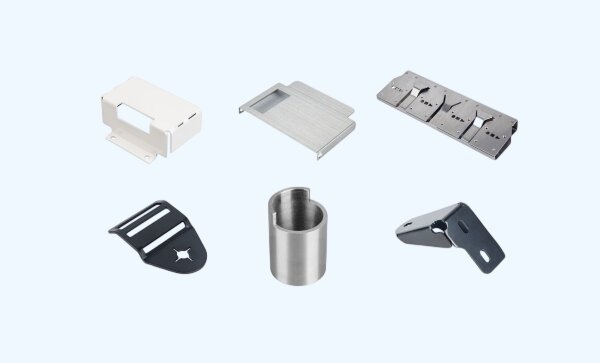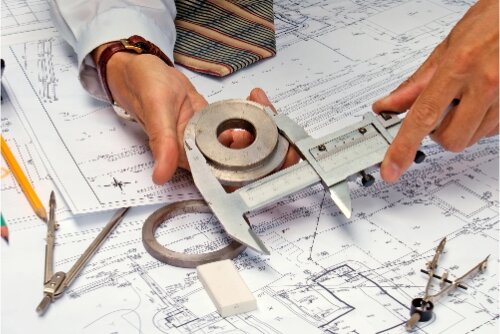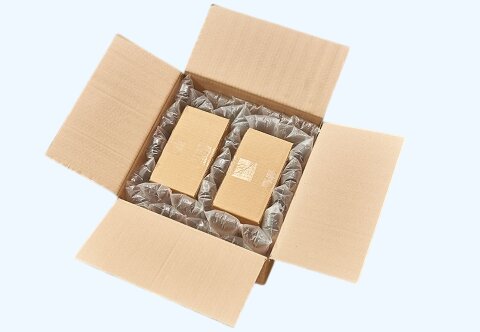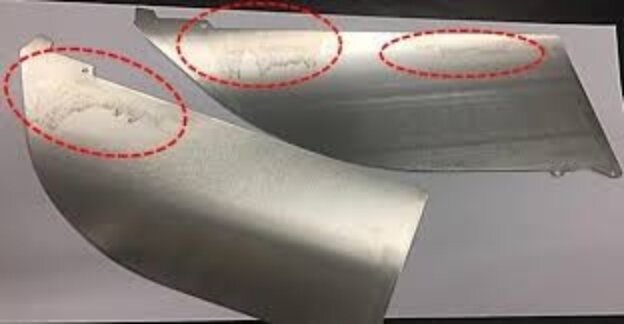제품 설계 및 제조에서는 속도와 유연성이 핵심입니다. 그러나 금속으로 작업하면 설정이 느리고 비용이 많이 들며 리드 타임이 길어지는 경우가 많습니다. 금속 바인더 제팅이 해결책을 제시합니다. 이 솔루션은 엔지니어와 제조업체가 금속 부품 생산에 접근하는 방식을 더 빠르고 유연하며 경제적으로 바꿔줍니다.
이 방법은 항공우주, 자동차 및 의료 산업에서 인기를 얻고 있습니다. 어떻게 작동하는지, 왜 더 많은 기업이 이 방법을 사용하는지 살펴보겠습니다.
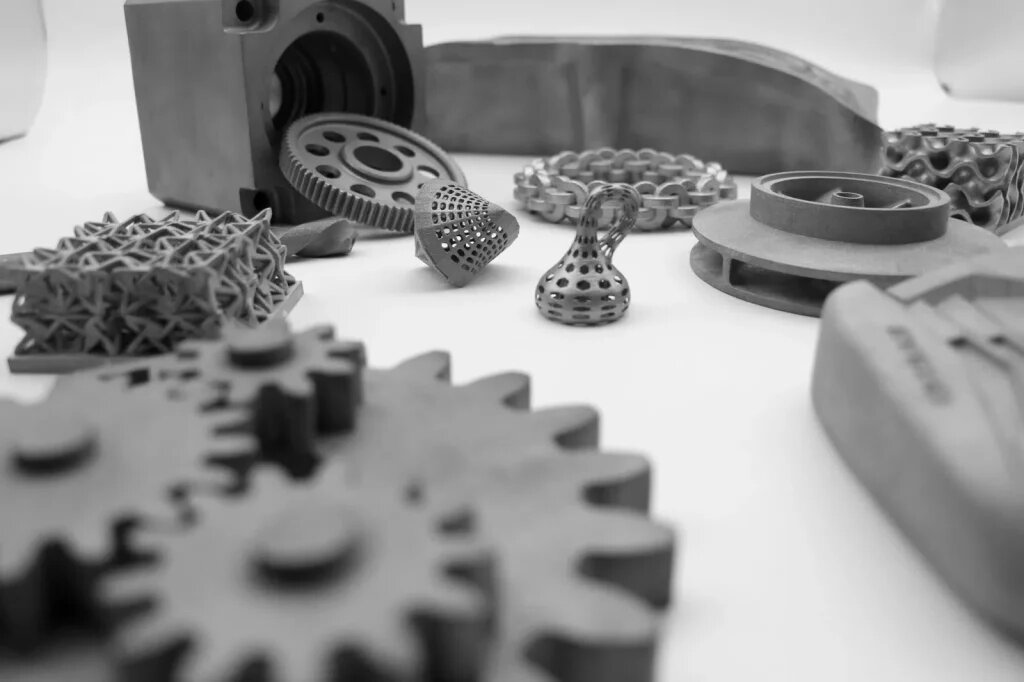
메탈 바인더 제팅이란?
금속 바인더 제팅은 적층 제조 공정입니다. 이 공정은 빌드 플랫폼에 얇은 금속 분말 층을 펼치는 것으로 시작됩니다. 프린트 헤드가 표면 위로 이동하여 선택한 영역에 액체 바인더를 증착합니다. 이 바인더는 파우더를 하나로 묶어줍니다. 그런 다음 다른 파우더 층을 추가하고 이 과정을 반복합니다.
기계가 파트를 레이어별로 제작합니다. 완성된 부품을 "녹색 부품"이라고 합니다. 부드럽고 깨지기 쉽습니다. 그런 다음 부품은 건조 및 소결 과정을 거칩니다. 소결에는 용광로에서 금속이 녹을 때까지 가열하는 과정이 포함됩니다. 그 결과 조밀하고 견고한 금속 부품이 완성됩니다.
이 방법은 레이저나 용융을 사용하지 않습니다. 따라서 더 빠르며 인쇄하는 동안 상온에서 작동합니다. 따라서 부품에 가해지는 스트레스가 줄어들고 기계의 속도가 빨라집니다.
금속 바인더 제팅은 어떻게 작동합니까?
금속 바인더 제팅은 분말 금속과 바인딩 에이전트를 사용하여 부품을 한 층씩 제작합니다. 단계별 분석은 다음과 같습니다:
파일 준비 및 슬라이싱
이 프로세스는 CAD 소프트웨어에서 생성된 3D 모델로 시작됩니다. 이 모델은 STL 파일로 내보내집니다. 그런 다음 특수 소프트웨어를 사용하여 파일을 얇은 레이어로 슬라이스합니다. 각 슬라이스는 프린터가 제작할 하나의 레이어를 나타냅니다.
또한 이 소프트웨어는 다음과 같은 필수 인쇄 매개변수도 설정합니다:
- 레이어 두께: 일반적으로 50~100미크론 사이로 설정되며 디테일과 표면 마감에 영향을 줍니다.
- 바인더 채도: 보통 50-70% 채도, 레이어당 바인더 사용량을 제어합니다.
- 빌드 방향: 소결 후 수축과 뒤틀림을 최소화하기 위해 엄선된 소재입니다.
금속 바인더를 분사하면 일반적으로 소결 중에 15-20%의 수축이 발생하므로 이러한 설정은 매우 중요합니다. 적절한 계획은 최종 제품의 높은 정확도를 달성하는 데 도움이 됩니다.
슬라이싱이 완료되면 파일이 프린터로 전송됩니다.
레이어링 및 바인더 애플리케이션
바인더 제팅 프린터 내부의 빌드 플랫폼에 미세한 금속 분말 층이 고르게 퍼집니다. 리코터 블레이드 또는 롤러가 이 파우더 층을 조심스럽게 다듬어 균일한 두께를 보장합니다.
그런 다음 잉크젯 프린트 헤드가 파우더 베드를 가로질러 이동하면서 부품이 설계된 위치에 액체 바인더를 미세한 방울로 분사합니다. 이 바인더는 건조되면서 약간 굳어져 파우더 입자를 특정 층 모양으로 결합합니다.
그런 다음 빌드 플랫폼은 일반적으로 약 50-100미크론의 레이어 높이로 한 층씩 낮아집니다. 새로운 금속 분말 층이 펼쳐지고 바인더 적용이 반복됩니다. 이 과정은 전체 부품이 형성될 때까지 레이어별로 계속됩니다.
경화 및 후처리
인쇄 직후의 결과물인 '녹색 부분'은 여전히 섬세하고 다공성입니다. 이 단계에서는 부피 기준으로 약 40~50% 바인더 재료가 포함될 수 있습니다. 손상을 방지하려면 조심스럽게 다루어야 합니다.
프린팅 후 첫 번째 단계는 경화입니다. 부품을 보통 약 150~200°C에서 몇 시간 동안 부드럽게 가열하여 잔여 수분을 완전히 증발시키고 바인더를 굳힙니다.
다음 단계는 소결 준비를 위해 대부분의 바인더 재료를 제거하는 디바인딩입니다. 디바인딩에는 일반적으로 부품을 약 400~600°C로 가열하거나 화학 용매를 사용하여 바인더를 용해하는 과정이 포함됩니다.
마지막으로 부품은 사용되는 금속 합금에 따라 금속의 녹는점(보통 1100°C에서 1400°C 사이)에 가깝지만 그 이하로 가열하는 고온 단계인 소결 과정을 거칩니다. 소결하는 동안 금속 입자가 융합되어 밀도가 크게 증가합니다.
소결 후 부품은 기존 방식으로 제조된 부품과 유사한 강도를 가지며, 스테인리스 스틸 또는 니켈 합금과 같은 소재의 경우 600MPa에서 최대 1000MPa의 최종 인장 강도에 도달합니다.
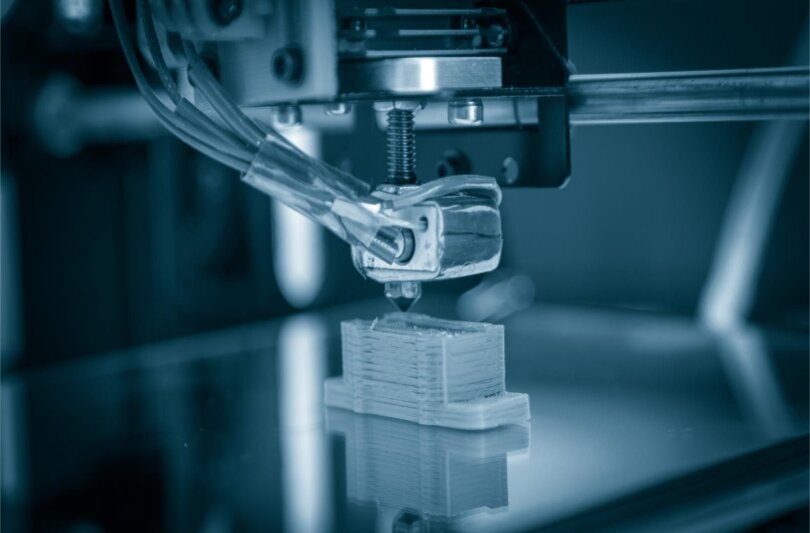
금속 바인더 제팅에 사용되는 재료
재료 선택은 부품 강도, 마감 및 비용에 영향을 미칩니다. 금속 바인더 제팅은 여러 유형의 금속 분말과 함께 작동합니다. 가장 일반적인 것은 다음과 같습니다:
- 스테인레스 스틸 (예: 316L 및 17-4 PH): 내식성과 강도에 좋습니다.
- 공구강: 절삭 공구 및 금형과 같은 내마모성 부품에 사용됩니다.
- 인코넬: 고온 또는 혹독한 환경에서 사용되는 니켈 합금.
- 구리: 높은 전기 및 열 전도성 때문에 선택되었습니다.
- 티탄: 가볍고 튼튼하여 항공우주 및 의료 부품에 사용됩니다.
금속 바인더 제팅을 위한 설계 가이드라인
바인더 제팅을 위한 설계는 기존의 기계 가공이나 주조와는 다릅니다. 부품은 수축, 파우더 흐름 및 후처리를 고려해야 합니다.
공차 및 벽 두께 권장 사항
인쇄된 부품은 소결 중에 수축하는 경우가 많습니다. 수축률은 15%에서 20%까지 다양합니다. 설계자는 수축 후 최종 부품 크기에 맞게 CAD 모델의 크기를 조정해야 합니다.
- 최소 벽 두께: 대부분의 금속의 경우 약 1mm. 더 얇은 벽은 디바인딩 또는 소결 중에 파손될 수 있습니다.
- 허용 오차 범위소결 후 ±0.2mm가 일반적입니다. 더 높은 정확도를 위해서는 2차 가공이 필요할 수 있습니다.
작은 구멍이나 나사산과 같은 피처는 엄격한 공차 또는 매끄러운 마감을 위해 후처리가 필요할 수 있습니다.
지원 구조 및 축소 보상
바인더 제팅의 중요한 장점 중 하나는 인쇄 중에 지지 구조가 필요 없다는 것입니다. 주변의 파우더가 자연스러운 지지대 역할을 합니다. 따라서 SLM이나 DMLS와 같은 공정에 비해 더 자유로운 디자인이 가능합니다.
그러나 부품은 불균일한 수축이나 중력으로 인해 소결 중에 변형될 수 있습니다. 따라서 인쇄 서포트와는 다른 소결 서포트가 필요할 때가 있습니다. 후처리 과정에서 부품이 용광로에서 모양을 유지하도록 돕기 위해 추가됩니다.
소프트웨어에 수축 보정 기능이 내장되어 있습니다. 하지만 복잡한 모양은 불균일하게 줄어들 수 있습니다. 디자이너는 날카로운 내부 모서리나 지지되지 않는 긴 스팬을 피해야 합니다.
디자인 최적화를 위한 팁
- 벽 두께를 일정하게 유지하여 뒤틀림을 줄이세요.
- 날카로운 모서리 대신 필렛을 사용하여 스트레스 지점을 피하세요.
- 소결 중에 휘어지거나 말릴 수 있는 평평한 표면은 피하세요.
- 두꺼운 부분을 비워 무게를 줄이고 소결 속도를 높입니다.
- 밀폐된 공간에 갇힌 파우더를 위한 탈출 구멍을 추가합니다.
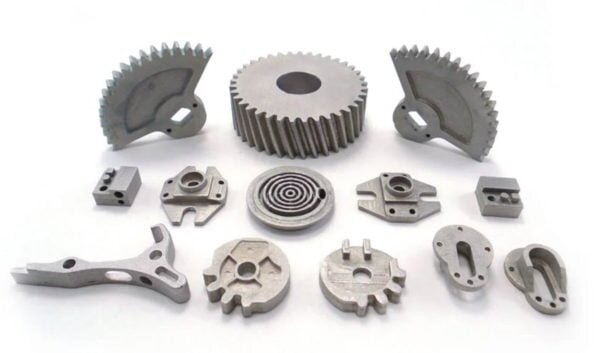
금속 바인더 제팅의 장점
금속 바인더 제팅은 생산에 여러 가지 이점을 제공합니다. 시간을 절약하고 낭비를 줄이며 복잡한 디자인에 적합합니다.
복잡한 부품을 위한 고속 생산
바인더 젯팅 인쇄 속도가 가장 빠름 금속 3D 프린팅 방법을 사용합니다. 파우더를 퍼뜨려 몇 초 만에 각 층을 결합하고 금속을 녹일 필요가 없으므로 레이저 기반 인쇄보다 훨씬 빠른 공정이 가능합니다.
빠른 속도로 리드 타임을 단축할 수 있습니다. 한 번에 여러 파트를 제작하는 데 이상적입니다. 전체 제작 영역을 파트로 채우고 함께 프린트할 수 있습니다. 금속 부품을 소량에서 중량으로 배치해야 할 때 유용합니다.
감산 방식에 비해 재료 낭비 감소
기존 가공은 단단한 블록에서 금속을 절단하여 많은 양의 스크랩을 생성합니다. 바인더 제팅은 부품에 필요한 파우더만 사용하여 부품을 한 층씩 제작합니다.
사용하지 않은 파우더는 빌드 박스에 남아 있습니다. 이를 수거하여 재사용할 수 있으므로 재료 비용과 폐기물을 줄일 수 있습니다. 또한 재활용 또는 폐기 단계의 필요성도 줄어듭니다.
인쇄 중 지지 구조물 필요 없음
대부분의 3D 금속 프린팅 공정에는 서포트가 필요합니다. 서포트는 파트가 프린트되는 동안 파트를 고정하는 추가 구조물입니다. 서포트를 제거하면 시간이 더 걸리고 파트가 손상될 수 있습니다.
지지대 없이 인쇄물을 분사하는 바인더. 각 부분 주위에 루스 파우더가 충분한 지지력을 제공하여 프로세스가 더 부드러워집니다. 돌출부를 지지하는 방법에 대해 걱정할 필요 없이 자유롭게 디자인할 수 있습니다.
과제와 한계
바인더 제팅은 속도와 유연성을 제공하지만, 몇 가지 단점이 있습니다. 이러한 문제는 강도, 정확성 및 안전성에 영향을 미칩니다.
부품 강도 및 밀도 문제
바인더 제팅으로 제작된 부품은 기계 가공이나 금속 사출 성형으로 제작된 부품만큼 밀도가 높지 않습니다. 소결 후 부품 내부에 작은 틈이 남을 수 있습니다. 이러한 틈은 강도를 떨어뜨립니다.
이로 인해 구조용 또는 고하중 애플리케이션에서는 바인더 분사 사용이 제한될 수 있습니다. 높은 내구성이 필요한 부품에는 후처리 또는 밀도가 높은 방법을 사용하는 것이 더 바람직할 수 있습니다.
치수 정확도 및 수축 제어
바인더 분사 부품은 소결 중에 수축합니다. 수축은 바인더가 연소되고 금속이 융합되기 때문에 발생합니다.
이 수축을 제어하는 것은 까다롭습니다. 설정이 꺼져 있으면 최종 부품이 약간 작아지거나 모양이 변형될 수 있습니다. 디자인 및 인쇄 단계에서 수축을 고려해야 합니다.
바인더 안전 및 취급 요건
바인더에는 화학 물질이 포함되어 있습니다. 일부는 적절하게 취급하지 않으면 인화성이 있거나 위험할 수 있습니다. 인쇄 및 경화 중에는 적절한 환기가 필요합니다.
작업자는 화재나 건강상의 위험을 피하기 위해 보호 장비를 착용하고 보관 및 폐기물 취급 규칙을 준수해야 합니다.
산업 전반의 애플리케이션
금속 바인더 제팅은 많은 산업 분야에서 사용됩니다. 복잡한 금속 부품을 빠르고 저렴한 비용으로 제작하는 데 도움이 됩니다.
항공우주 부품 및 경량 구조물
항공우주 분야에서는 무게 감소가 최우선 과제입니다. 바인더 제팅은 중공 또는 격자로 채워진 부품을 생성하여 강도를 잃지 않으면서 무게를 줄일 수 있습니다.
또한 다음과 같은 빠른 프로토타이핑을 지원합니다. 괄호, 인클로저및 마운트. 이를 통해 엔지니어는 전체 생산 전에 설계를 테스트할 수 있습니다. 한 번의 빌드에서 여러 파트를 프린팅할 수 있어 개발 주기가 단축됩니다.
자동차 프로토타이핑 및 커스터마이징
자동차 제조업체는 설계 단계에서 바인더 젯팅을 사용하여 엔진 부품, 브래킷, 열 차폐막을 제작합니다. 툴링을 기다릴 필요 없이 모양과 핏을 테스트할 수 있습니다.
또한 한정 생산 또는 고급 차량을 위한 맞춤형 부품도 지원합니다. 디자인을 빠르게 변경하고 필요에 따라 인쇄할 수 있습니다. 이러한 유연성 덕분에 기계 가공에 비해 비용과 시간을 절약할 수 있습니다.
의료 도구 및 임플란트
바인더 젯팅은 맞춤형 임플란트 및 수술 도구의 소량 생산을 지원합니다. 환자 개개인이 다르기 때문에 맞춤형 부품은 매우 중요합니다.
의사와 엔지니어는 환자의 해부학적 구조와 일치하는 형상을 만들 수 있습니다. 이 프로세스는 유체 흐름을 위한 내부 채널이나 경량 메시 구조와 같은 복잡한 형상을 처리합니다.
산업용 지그, 픽스처 및 최종 사용 부품
공장에서 바인더 제팅은 공구, 지그, 픽스처를 생산하는 데 도움이 됩니다. 이러한 부품은 제조 과정에서 부품을 안내하고 고정하거나 위치를 지정하는 데 도움이 됩니다.
바인더 젯팅은 특수한 모양의 견고한 부품이 필요할 때 빠른 옵션입니다. 예비 부품과 소량의 금속 부품에도 적합합니다.
결론
금속 바인더 제팅은 복잡한 금속 부품을 빠르고 유연하게 제작할 수 있는 방법입니다. 금속 파우더와 바인더로 프린팅한 후 소결을 통해 부품을 완성합니다. 이 프로세스는 폐기물을 줄이고 생산 속도를 높이며 지지 구조물을 피하는 데 도움이 됩니다. 맞춤형 부품, 소량 배치 및 세부 디자인에 적합합니다.
다음 프로젝트를 위해 금속 바인더 제팅에 대해 알아보고 싶으신가요? 당사의 팀이 적절한 공정을 선택하고 디자인을 고품질 금속 부품으로 제작할 수 있도록 도와드립니다. 지금 바로 문의하세요 를 통해 요구 사항을 논의하고 빠른 견적을 받아보세요.
안녕하세요, 저는 케빈 리입니다

지난 10년 동안 저는 다양한 형태의 판금 제작에 몰두해 왔으며 다양한 워크숍에서 얻은 경험에서 얻은 멋진 통찰력을 이곳에서 공유했습니다.
연락하세요

케빈 리
저는 레이저 절단, 굽힘, 용접 및 표면 처리 기술을 전문으로 하는 판금 제조 분야에서 10년 이상의 전문 경험을 갖고 있습니다. Shengen의 기술 이사로서 저는 복잡한 제조 문제를 해결하고 각 프로젝트에서 혁신과 품질을 주도하는 데 최선을 다하고 있습니다.

